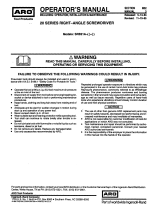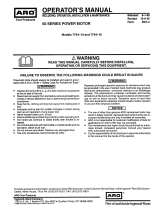
Lack of or an excessive amount of lubrication will aect the perform-
ance and life of this tool. Use only recommended lubricants at below
time intervals:
Every 8 Hours of Tool Operation, Fill lubricator reservoir of recom-
mended F.R.L. with spindle oil (29665). If an in line or air line lubrica-
tor is not used, apply several drops of spindle oil (29665) in air inlet.
Every 40 Hours Of Tool Operation, Flush tool with a solution of
three (3) parts cleaning solvent to one (1) part spindle oil. After ush-
ing, apply a small amount of spindle oil in air inlet and run tool for
one minute to insure proper lubrication. Built-in oiler reservoir (pistol
grip models) should be lled with spindle oil (29665).
Every 160 Hours of Tool Operation, Lubricate gearing. Pack bear-
ings, coat shafts and lubricate gears with NLGl #1 “EP” grease (33153).
Gearing should contain approximately 1/4 oz. (7 g) of grease per
reduction.
Product Safety Information
Intended Use:
These Air Drills are designed for drilling, honing, reaming and hole sawing.
For Additional information refer to Air Drills Product Safety Information Manual Form 04580353.
Manuals can be downloaded from www.irtools.com.
Routine Lubrication Requirements
For maximum operating eciency, the following air supply specica-
tions should be maintained to this air tool:
AIR PRESSURE - 90 p.s.i.g. (6.2 bar)
AIR FILTRATION - 50 micron
LUBRICATED AIR SUPPLY
HOSE SIZE - 5/16” (8 mm) I.D.
A model C28231-810 air line FILTER/REGULATOR/LUBRICATOR (F.R.L.)
is recommended to maintain the above air supply specications.
Air Supply Requirements
Recommended Lubricants
After disassembly is complete, all parts, except sealed or shielded
bearings, should be washed with solvent. To relubricate parts, or for
routine lubrication, use the following recommended lubricants:
Where Used
Air Motor
O-Rings & Lip Seals
Gears and Bearings
Ingersoll Rand Part #
29665
36460
33153
Description
1 qt. Spindle Oil
4 oz. Stringy Lubricant
5 lb. "EP" - NLGI # 1 Grease
Inspection, Maintenance and Installation
Disconnect air supply from the tool or shut o air supply and exhaust
(drain) line of compressed air before performing maintenance or
service to the tool.
It is important that the tools be serviced and inspected at regular
intervals for maintaining safe, trouble-free operation of the tool.
Be sure the tool is receiving adequate lubrication, as failure to
lubricate can create hazardous operating conditions resulting from
excessive wear.
Be sure that the air supply lines and connectors are of proper size to
provide a sucient quantity of air to the tool.
Tool maintenance and repair shall be performed by authorized,
trained, competent personnel. Tools, hose and ttings shall be
replaced if unsuitable for safe operation and responsibility should
be assigned to be sure that all tools requiring guards or other safety
devices shall be kept in legible condition. Maintenance and repair
records should be maintained on all tools. Frequency of repair and
the nature of the repairs can reveal unsafe application. Scheduled
maintenance by competent authorized personnel should detect any
mistreatment or abuse of the tool and worn parts. Corrective action
should be taken before returning the tool for use.
Disassembly should be done on a clean work bench with a clean
cloth spread to prevent the loss of small parts. After disassembly is
completed, all parts should be thoroughly washed in a clean solvent,
blown dry with air and inspected for wear levels, abuse and contami-
nation. Double sealed or shielded bearings should never be placed
in solvent unless a good method of re-lubricating the bearing is
available. Open bearings may be washed but should not be allowed
to spin while being blown dry.
Upon reassembling, lubricate parts where required. Use 33153
grease, or equivalent, in bearings. Use 36460 lubricant for O-ring
assembly. When assembling O-Rings or parts adjacent O-rings, care
must be exercised to prevent damage to the rubber sealing surfaces.
A small amount of grease will usually hold steel balls and other small
parts in place while assembling.
When replacement parts are necessary, consult drawing containing
the part for identication.
Always use clean, dry air. Dust, corrosive fumes and/or excessive mois-
ture can damage the motor of an air tool. An air line lter can greatly
increase the life of an air tool. The lter removes rust, scale, moisture
and other debris from the air lines. Low air pressure (less than 90 p.s.i.g.)
reduces the speed of the air tool. High air pressure (more than 90 p.s.i.g.)
raises performance beyond the rated capacity of the tool and could
cause injury. Shown below is a typical piping arrangement.
To Air
Tool
To Air
System
Main lines 3 times Air
Tool inlet size
Branch line 2 times air
tool inlet size
Drain Regulary
Compressor
Lubricator
Regulator
Filter

















